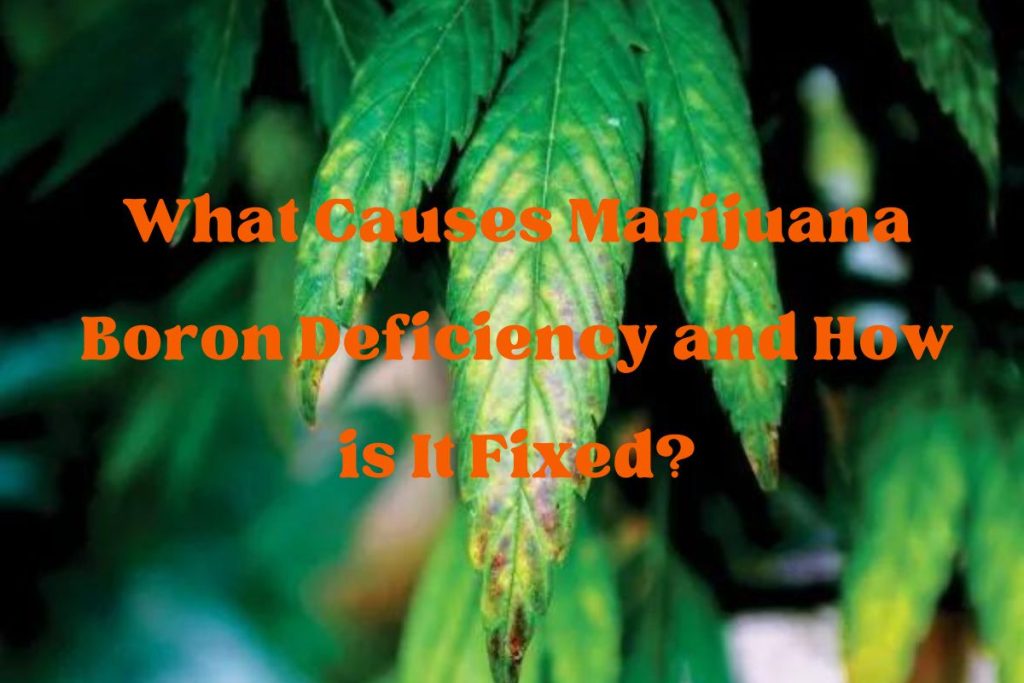What Causes Marijuana Boron Deficiency and How is It Fixed?

For marijuana plants to grow healthy and to produce good yields, you must provide the right growing nutrients. There are major nutrients needed by cannabis plants and usually, these are nutrients that are part of most plant food and supplements: nitrogen, phosphorus, and potassium. These nutrients are needed for healthy growth and flowering phases. There are also minor nutrients that are vital for plant health such as boron. Marijuana boron deficiency is a nutrient problem that happens to cannabis plants when it is underwatered or when the plant is grown in a dry environment.
What Does Boron Deficiency Look Like?
Boron deficiency is a rare condition and is usually accompanied by other types of nutrient or pH problems. Boron deficiency may appear from the leaves but may also affect other parts of the plant. The very first sign of boron deficiency is an abnormal thick growth of the leaves especially the young leaves. There is also yellowing as well as spotting found on the surface of the leaves.
When there’s boron deficiency, the younger and upper leaves may show signs of abnormal growth. Usually, the leaf tip will not grow correctly and there is noticeable twisting. Also, new leaves may start to curl and wrinkle.
Although it may be difficult to see, the plant roots are also affected by a boron deficiency. Affected roots will grow very slowly and will also look very unhealthy. The roots may look like the roots of plants that have not received enough water or are grown in dry air.
Cannabis plants with boron deficiency may look similar to those with calcium deficiency. This is because plants require boron to absorb calcium better. The most commonly affected parts are the new leaves and stems and may look like the tips were purposely burnt. Boron deficiency happens together with other nutrient problems such as potassium and nitrogen deficiencies. These nutrients help the plant utilize boron.
What Causes Marijuana Boron Deficiency?
Although cannabis plants will survive just about any kind of environment, severe dry air or very low humidity can take a toll. Aside from potassium and nitrogen problems, boron deficiency may arise.
Another common cause of boron and other nutrient deficiencies is stress. If the condition is not too severe, boron deficiency may clear up without any intervention. But if you overlook stress, nutrient deficiencies may worsen. This time, you need to fix the problem before it’s too late.
How to Fix Marijuana Boron Deficiency?
Boron deficiency is fixable unless the problem has turned for the worse. If you notice only a few young leaves starting to wrinkle and show yellow or burning spots then try to correct humidity and check the content of the marijuana plant food you are using. If the condition has affected more leaves, it’s time to use more drastic measures.
Provide correct cannabis plant nutrients
Cannabis plants require different nutrients depending on their growth cycle, thus, vegging plants need a different set of nutrients than flowering plants. At the vegging stage, nitrogen is most important and is higher than other major and minor nutrients like potassium and phosphorus. During the flowering stage, nitrogen levels are low as plants don’t need this nutrient. Potassium and phosphorus are higher as they are important in bud growth and development.
As boron is related to nitrogen and potassium absorption, consider providing correct levels during all the growth phases. Also, use organic soil as much as possible. Organic soil meant for cannabis plants contain all the necessary nutrients for plant growth during the vegetative and flowering stages. Organic soil also has natural components and thus, is safe for plants.
Do not use time-release nutrients or plant food or an all-in-one plant food as these may incorrectly add nutrients that are not needed by your plants. Also, there is no all-in-one food as cannabis plants require different sets of nutrients for every stage.
Correct root pH as soon as possible
Soil and root pH must be measured as this is where nutrients are absorbed by plants. If there’s anything off at this level, boron and other nutrients may not be absorbed in all. And because boron absorption is also affected by other nutrients, any problems with other nutrients will surely result in deficiencies.
In soil, nutrients like boron are best absorbed by the roots when the pH is 6.0 – 6.5 pH. Boron is absorbed in 6.0 – 7.0 but it’s best to consider levels of 6.5. When growing plants in hydro, boron is absorbed in 5.5 – 6.2 pH.
Improve moisture and humidity levels
Boron needs moisture to be fully absorbed. If your plants are underwatered or there is very low humidity below 25% relative humidity, this nutrient may not be properly absorbed by the roots. Consider the best watering practices. Water as soon as you see dry soil but not too dry that makes the soil flake off or crumble into small pieces. Never overwater as well as cannabis plants may not survive too much water. Overwatering also affects the absorption of many nutrients.
Monitor your plants for recovery
If you suspect boron deficiency, flush your roots and soil with clean, pH’d water. Use regular cannabis nutrients and avoid homemade plant food. Check for progress daily; usually, cannabis that suffers from boron deficiency recover quickly. You can see that your plants have recovered if their condition has not worsened. Leaves that have changed color, thickness, and overall appearance will never regain their healthy form.
Correct other nutrient deficiencies
Consider replacing your plant food if the condition persists. Choose organic cannabis plant food with complete nutrients. You might be tempted to use boron products like Borax, Boric Acid, or Solubor, three very popular boron sources used by experts. Follow directions on how to apply these products to avoid costly mistakes.
Conclusion
Marijuana boron deficiency is manageable and plants that survive grow into healthy, high-yielding plants. Always closely monitor your plants’ growth and development to check and correct any deficiency or nutrient problem before things become out of hand.



